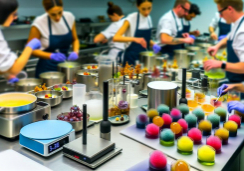Essential Tips for Developing Healthy Vegan Recipes
Navigating the world of vegan cooking can sometimes feel like walking through a minefield—full of potential missteps but also opportunities for exciting discoveries. As you embark on crafting nourishing and flavor-packed vegan recipes, it's crucial to understand the cornerstones of nutritional balance and how to harness plant-based proteins effectively.
You'll want to get creative with natural flavor enhancers and whole grains, all while keeping your kitchen brimming with the freshest produce. But how do you ensure that your dishes aren't just healthy, but also satisfying and diverse in texture and taste?
Stick with me, and I'll share essential tips that'll help you build a repertoire of vegan recipes that are not only good for the body but also a delight for the senses.
Understand Nutritional Balance
To ensure your vegan meals support your health, it's crucial to balance macronutrients—carbohydrates, proteins, and fats—alongside a spectrum of vitamins and minerals. The key is to include a variety of essential nutrients that your body requires for optimal functioning.
Start by incorporating a mix of whole grains and legumes, which provide complex carbohydrates and ample protein. Add in leafy greens like spinach or kale to ensure a rich intake of vitamins and minerals.
Healthy fats are also vital, so don't shy away from avocados, nuts, and seeds. Ground flaxseed, in particular, is a great addition for omega-3 fatty acids, which are important for heart health.
To boost the flavor and nutritional profile of your dishes, consider using nutritional yeast, which is a complete protein and is fortified with B vitamins, or miso paste, which adds a depth of taste and beneficial probiotics.
Master Plant-Based Proteins
As you explore the world of plant-based proteins, remember the importance of variety. You'll want to mix legumes, nuts, and grains to get all the essential amino acids your body needs.
And don't forget to pair proteins like beans with rice, which together offer a complete protein profile that's crucial for your health.
Diverse Protein Sources
Mastering plant-based proteins, such as lentils, chickpeas, quinoa, and tofu, is essential for creating nutritious and satisfying vegan recipes. Your vegan diet thrives on these diverse protein sources, each contributing to a rich flavor profile.
When creating delicious vegan meals, experiment with marinating tofu in soy sauce or grilling it to enhance its taste and texture. Embrace the power of combination by pairing beans with rice, ensuring your dish offers a complete amino acid profile.
Don't overlook the potential of seitan, hemp seeds, or nutritional yeast to add variety to your protein intake. Additionally, integrating protein-packed vegetables like spinach, broccoli, and Brussels sprouts lays a healthy vegan foundation.
These strategies will ensure your vegan recipes are as wholesome as they're flavorful.
Protein Pairing Essentials
Understanding how to pair plant-based proteins is crucial for ensuring your vegan meals are complete in essential amino acids. When you're meal prepping, remember that protein pairing essentials can turn simple vegan dishes into delicious vegan meals that support your health. Legumes, nuts, seeds, and grains are the cornerstones of vegan cooking. Try combinations like beans with rice or lentils with quinoa to cover all your amino acid needs.
Don't be afraid to experiment with tofu, tempeh, seitan, and edamame to boost the protein content. These ingredients not only contribute to the nutritional value but also enhance the flavor and texture of your creations.
And don't overlook vegan cheeses; they can add a delightful twist to your protein pairings.
Enhance Flavors Naturally
To elevate your vegan dishes, incorporate fresh herbs for a burst of flavor and a nutritional boost without added fats or sugars.
Roasting your vegetables can intensify their inherent sweetness and rich taste, providing a satisfying complexity to your meals.
Don't hesitate to experiment with a spectrum of spices to keep your culinary creations vibrant and full of flavor.
Utilize Fresh Herbs
Incorporating fresh herbs like basil, cilantro, and parsley can significantly enhance the natural flavors of your vegan dishes. These vibrant greens not only add flavor but also infuse your meals with a variety of nutrients.
Experimenting with these herbs is easy to make your healthy vegan recipes full of flavor. For instance, a splash of olive oil and chopped basil can transform a simple tomato sauce into a gourmet experience.
As New Year's resolutions kick in, fresh herbs are your ally in creating exciting, yet nutrient-packed dishes without relying on excess salt or artificial flavorings.
Roast Vegetables Thoroughly
Unlock the natural sweetness and robust flavors in your vegan dishes by roasting your vegetables until they're deliciously caramelized and nutrient-rich.
This method is essential for creating easy and delicious vegan meals that are both satisfying and healthful. When you're Going Vegan, incorporating new ingredients is key—roasting offers a chance to explore the depth of flavors vegetables can offer.
A drizzle of maple syrup can elevate the taste further without adding unhealthy additives. Moreover, roast vegetables thoroughly to ensure they retain their nutrients, providing a balanced approach to your diet.
And don't forget the convenience factor—using a One Pot technique can save time and streamline your cooking process, making it easier to enjoy a variety of roasted veggies in your meal planning.
Experiment With Spices
While roasting vegetables brings out their natural sweetness, adding a dash of carefully selected spices can further amplify the flavors in your vegan creations. Spices are the secret to transforming simple ingredients into delicious, nutrient-packed meals. Here's how to do it:
- Add Salt Sparingly: Begin with a small amount of salt to enhance the natural flavors of your ingredients.
- Build Complexity: Use spices like smoked paprika or turmeric to add depth to your dishes.
- Mix and Match: Don't be afraid to experiment with different spice combinations to keep popular vegan recipes exciting.
- Prevent Boredom: If you're getting bored with an old favourite, introducing a new spice can completely reinvent the dish.
Experiment With Whole Grains
Dive into the world of whole grains by trying quinoa, brown rice, farro, and barley to enhance the nutritional value and variety of your vegan dishes. These power-packed grains aren't only versatile but also brimming with essential nutrients that are vital for a balanced vegan diet.
By incorporating whole grains, your meals become more satiating, ensuring you're fueled for longer.
Whole grains can easily become the backbone of your new favorite vegan creations. Imagine a warm quinoa salad with roasted vegetables or a comforting barley risotto—these could be your next go-to dishes. Integrating whole grains into soups, stews, and casseroles not only adds complexity to the texture but also significantly bumps up the fiber content, which is crucial for maintaining a healthy digestive system.
Making a lifestyle change to a vegan diet sounds daunting to some, but it's an opportunity to discover a plethora of new and exciting foods. Opt for whole grain pasta and bread to keep things interesting and nutritious. And don't overlook the potential of whole grain flours in baking; they can impart a delightful, nutty flavor to your vegan treats.
Whole grains aren't just a healthy choice; they're the cornerstone of a diverse and delicious vegan diet.
What are the key tips for developing healthy vegan recipes?
When creating healthy vegan recipes, it’s important to keep in mind a few essential vegan recipe tips. First, make sure to incorporate a variety of plant-based proteins like tofu, lentils, and quinoa. Second, focus on using fresh, seasonal produce to maximize flavor and nutrients. Lastly, don’t be afraid to experiment with herbs and spices to enhance the taste of your dishes.
Prioritize Fresh Produce
To maximize the nutritional impact and flavor of your vegan meals, it's essential to prioritize a variety of fresh produce in your recipes. When you focus on whole plant foods, you're not only ditching animal products like meat and dairy, but you're also filling your plate with a rainbow of nutrients. Here's how to make the most of your time in the kitchen with fresh produce:
- Seasonal Selections: Choose seasonal fruits and vegetables. They're not only fresher and tastier but often much cheaper and more sustainable.
- Cooking Creativity: Experiment with different cooking methods. Try grilling for a smoky flavor, roasting to bring out natural sweetness, or using raw preparations to keep nutrients intact.
- Colorful Combinations: Create a visual feast with a mix of leafy greens, vibrant root veggies, and fresh herbs. This ensures a wide range of vitamins and minerals in your healthy vegan recipes.
- Local Love: Whenever possible, source your produce from local farmer's markets or CSA programs. You'll support the community and obtain the freshest ingredients possible.
Plan for Portion Sizes
Understanding how to measure and manage portion sizes is crucial in crafting healthy vegan recipes that fulfill your nutritional needs without leading to overconsumption. As you're developing your meal plans, remember that portion control is an essential tip for maintaining a balanced diet. Use measuring cups and scales to accurately gauge the amounts of ingredients in your dishes. This practice ensures that each meal is nutritionally adequate and helps in preventing the pitfalls of overeating.
Smaller plates and bowls can be a great opportunity to naturally limit portions without feeling deprived. This visual cue encourages you to eat less while still enjoying your food. When you've finished cooking, divide your meals into appropriate serving sizes. Storing leftovers in portioned containers makes it much better for you to grab a meal that's already balanced and ready to go.
Be particularly mindful of calorie-dense ingredients like nuts, seeds, and oils. While they're nutritious, their calories can add up quickly. Adjust portion sizes based on your personal energy needs, which vary according to your activity level and metabolic rate. By planning your portion sizes, you're taking a proactive step towards creating healthy vegan recipes that are as delicious as they're nutritious.
Conclusion
As you explore the vibrant world of vegan cooking, remember to balance your nutrients, embrace plant-based proteins, and boost flavors naturally.
Incorporate whole grains and fresh produce to keep your meals wholesome. Be mindful of portion sizes to maintain a healthy lifestyle.
With these tips, you'll create nutritious and delicious vegan recipes that not only satisfy your taste buds but also support your well-being.
Keep experimenting and enjoy the journey to a balanced, plant-powered diet.










